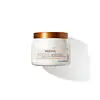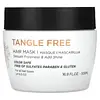What's inside
What's inside
 Key Ingredients
Key Ingredients

 Benefits
Benefits

 Concerns
Concerns

 Ingredients Side-by-side
Ingredients Side-by-side

Water
Skin ConditioningCetearyl Alcohol
EmollientAmodimethicone
Behentrimonium Chloride
PreservativeCetyl Esters
EmollientIsopropyl Alcohol
SolventParfum
MaskingTrideceth-6
EmulsifyingPhenoxyethanol
PreservativeMel
EmollientArgania Spinosa Kernel Oil
EmollientTheobroma Grandiflorum Seed Butter
Skin ConditioningCetrimonium Chloride
AntimicrobialChlorhexidine Dihydrochloride
AntimicrobialLinalool
PerfumingTocopherol
AntioxidantWater
Skin ConditioningCetearyl Alcohol
EmollientDimethicone
EmollientSteartrimonium Chloride
PreservativeParfum
MaskingAmodimethicone
Alcohol
AntimicrobialBenzyl Alcohol
PerfumingDimethiconol
EmollientPhenoxyethanol
PreservativeSodium Benzoate
MaskingLaureth-7
EmulsifyingTetrasodium EDTA
Cetyl Hydroxyethylcellulose
Emulsion StabilisingCitric Acid
BufferingPanthenol
Skin ConditioningAloe Barbadensis Leaf Juice
Skin ConditioningArgania Spinosa Kernel Oil
EmollientAstrocaryum Murumuru Seed Butter
EmollientHydrated Silica
AbrasiveSilica Dimethyl Silylate
EmollientDisodium Phosphate
BufferingSodium Phosphate
BufferingButylene Glycol
HumectantHydroxyacetophenone
AntioxidantWater, Cetearyl Alcohol, Dimethicone, Steartrimonium Chloride, Parfum, Amodimethicone, Alcohol, Benzyl Alcohol, Dimethiconol, Phenoxyethanol, Sodium Benzoate, Laureth-7, Tetrasodium EDTA, Cetyl Hydroxyethylcellulose, Citric Acid, Panthenol, Aloe Barbadensis Leaf Juice, Argania Spinosa Kernel Oil, Astrocaryum Murumuru Seed Butter, Hydrated Silica, Silica Dimethyl Silylate, Disodium Phosphate, Sodium Phosphate, Butylene Glycol, Hydroxyacetophenone
Ingredients Explained
These ingredients are found in both products.
Ingredients higher up in an ingredient list are typically present in a larger amount.
This water-soluble silicone is used for its hydrating and softening properties. It is used to add a silky feel to skincare products and has great benefits for haircare.
In haircare, this ingredient:
- Adds shine
- Protects color
- Offers thermal protection
- Boosts hair strength
- Does not build up as easily
You may know this ingredient as argan oil. Argan Oil has antioxidant, hydrating, and soothing properties.
Studies have shown argan oil can help fight again radical damage from the sun. This makes it effective at preventing hyperpigmentation.
Large amounts of vitamin E found in argan oil helps the skin retain water. Argan oil also contains fatty acids such as linoleic acid, oleic acid, and palmitic acid. It is also a good source of lipids.
Another benefit of argan oil is skin-soothing. It can help reduce inflammation-related skin symptoms.
Argan Oil is effective at regulating sebum production in pores. This can make it effective at treating hormonal acne.
Traditionally, argan oil was used for its antibacterial and antifungal properties. However, argan oil contains fatty acids that may make it not fungal-acne safe.
Argan Trees are native to Morocco.
Learn more about Argania Spinosa Kernel OilCetearyl alcohol is a mixture of two fatty alcohols: cetyl alcohol and stearyl alcohol. It is mainly used as an emulsifier. Emulsifiers help prevent the separation of oils and products. Due to its composition, it can also be used to thicken a product or help create foam.
Cetearyl alcohol is an emollient. Emollients help soothe and hydrate the skin by trapping moisture.
Studies show Cetearyl alcohol is non-toxic and non-irritating. The FDA allows products labeled "alcohol-free" to have fatty alcohols.
This ingredient is usually derived from plant oils such as palm, vegetable, or coconut oils. There is debate on whether this ingredient will cause acne.
Due to the fatty acid base, this ingredient may not be Malassezia folliculitis safe.
Learn more about Cetearyl AlcoholParfum is a catch-all term for an ingredient or more that is used to give a scent to products.
Also called "fragrance", this ingredient can be a blend of hundreds of chemicals or plant oils. This means every product with "fragrance" or "parfum" in the ingredients list is a different mixture.
For instance, Habanolide is a proprietary trade name for a specific aroma chemical. When used as a fragrance ingredient in cosmetics, most aroma chemicals fall under the broad labeling category of “FRAGRANCE” or “PARFUM” according to EU and US regulations.
The term 'parfum' or 'fragrance' is not regulated in many countries. In many cases, it is up to the brand to define this term.
For instance, many brands choose to label themselves as "fragrance-free" because they are not using synthetic fragrances. However, their products may still contain ingredients such as essential oils that are considered a fragrance by INCI standards.
One example is Calendula flower extract. Calendula is an essential oil that still imparts a scent or 'fragrance'.
Depending on the blend, the ingredients in the mixture can cause allergies and sensitivities on the skin. Some ingredients that are known EU allergens include linalool and citronellol.
Parfum can also be used to mask or cover an unpleasant scent.
The bottom line is: not all fragrances/parfum/ingredients are created equally. If you are worried about fragrances, we recommend taking a closer look at an ingredient. And of course, we always recommend speaking with a professional.
Learn more about ParfumPhenoxyethanol is a preservative that has germicide, antimicrobial, and aromatic properties. Studies show that phenoxyethanol can prevent microbial growth. By itself, it has a scent that is similar to that of a rose.
It's often used in formulations along with Caprylyl Glycol to preserve the shelf life of products.
Water. It's the most common cosmetic ingredient of all. You'll usually see it at the top of ingredient lists, meaning that it makes up the largest part of the product.
So why is it so popular? Water most often acts as a solvent - this means that it helps dissolve other ingredients into the formulation.
You'll also recognize water as that liquid we all need to stay alive. If you see this, drink a glass of water. Stay hydrated!
Learn more about Water